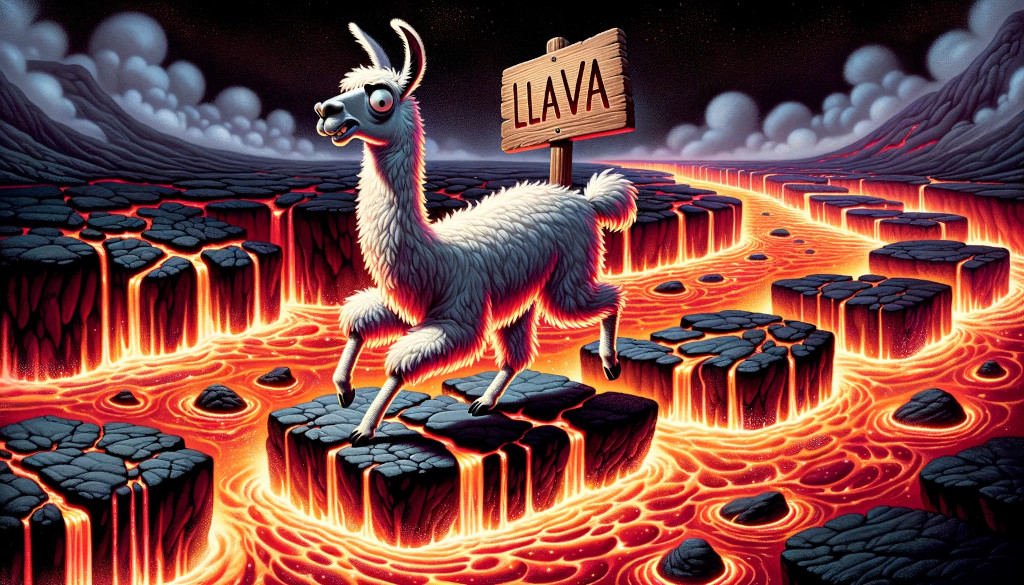moe-llava
Maintainer: camenduru

1.4K

| Property | Value |
|---|---|
| Run this model | Run on Replicate |
| API spec | View on Replicate |
| Github link | View on Github |
| Paper link | View on Arxiv |
Create account to get full access
Model overview
MoE-LLaVA is a large language model developed by the PKU-YuanGroup that combines the power of Mixture of Experts (MoE) and the versatility of Latent Learnable Visual Attention (LLaVA) to generate high-quality multimodal responses. It is similar to other large language models like ml-mgie, lgm, animate-lcm, cog-a1111-ui, and animagine-xl-3.1 that leverage the power of deep learning to create advanced natural language and image generation capabilities.
Model inputs and outputs
MoE-LLaVA takes two inputs: a text prompt and an image URL. The text prompt can be a natural language description of the desired output, and the image URL provides a visual reference for the model to incorporate into its response. The model then generates a text output that directly addresses the prompt and incorporates relevant information from the input image.
Inputs
- Input Text: A natural language description of the desired output
- Input Image: A URL pointing to an image that the model should incorporate into its response
Outputs
- Output Text: A generated response that addresses the input prompt and incorporates relevant information from the input image
Capabilities
MoE-LLaVA is capable of generating coherent and informative multimodal responses that combine natural language and visual information. It can be used for a variety of tasks, such as image captioning, visual question answering, and image-guided text generation.
What can I use it for?
You can use MoE-LLaVA for a variety of projects that require the integration of text and visual data. For example, you could use it to create image-guided tutorials, generate product descriptions that incorporate product images, or develop intelligent chatbots that can respond to user prompts with relevant visual information. By leveraging the model's multimodal capabilities, you can create rich and engaging content that resonates with your audience.
Things to try
One interesting thing to try with MoE-LLaVA is to experiment with different types of input images and text prompts. Try providing the model with a wide range of images, from landscapes and cityscapes to portraits and abstract art, and observe how the model's responses change. Similarly, experiment with different types of text prompts, from simple factual queries to more open-ended creative prompts. By exploring the model's behavior across a variety of inputs, you can gain a deeper understanding of its capabilities and potential applications.
This summary was produced with help from an AI and may contain inaccuracies - check out the links to read the original source documents!
Related Models

lgm

3
The lgm model is a Large Multi-View Gaussian Model for High-Resolution 3D Content Creation developed by camenduru. It is similar to other 3D content generation models like ml-mgie, instantmesh, and champ. These models aim to generate high-quality 3D content from text or image prompts. Model inputs and outputs The lgm model takes a text prompt, an input image, and a seed value as inputs. The text prompt is used to guide the generation of the 3D content, while the input image and seed value provide additional control over the output. Inputs Prompt**: A text prompt describing the desired 3D content Input Image**: An optional input image to guide the generation Seed**: An integer value to control the randomness of the output Outputs Output**: An array of URLs pointing to the generated 3D content Capabilities The lgm model can generate high-resolution 3D content from text prompts, with the ability to incorporate input images to guide the generation process. It is capable of producing diverse and detailed 3D models, making it a useful tool for 3D content creation workflows. What can I use it for? The lgm model can be utilized for a variety of 3D content creation tasks, such as generating 3D models for virtual environments, game assets, or architectural visualizations. By leveraging the text-to-3D capabilities of the model, users can quickly and easily create 3D content without the need for extensive 3D modeling expertise. Additionally, the ability to incorporate input images can be useful for tasks like 3D reconstruction or scene generation. Things to try Experiment with different text prompts to see the range of 3D content the lgm model can generate. Try incorporating various input images to guide the generation process and observe how the output changes. Additionally, explore the impact of adjusting the seed value to generate diverse variations of the same 3D content.
Updated Invalid Date

ml-mgie

5
ml-mgie is a model developed by Replicate's Camenduru that aims to provide guidance for instruction-based image editing using multimodal large language models. This model can be seen as an extension of similar efforts like llava-13b and champ, which also explore the intersection of language and visual AI. The model's capabilities include making targeted edits to images based on natural language instructions. Model inputs and outputs ml-mgie takes in an input image and a text prompt, and generates an edited image along with a textual description of the changes made. The input image can be any valid image, and the text prompt should describe the desired edits in natural language. Inputs Input Image**: The image to be edited Prompt**: A natural language description of the desired edits Outputs Edited Image**: The resulting image after applying the specified edits Text**: A textual description of the edits made to the input image Capabilities ml-mgie demonstrates the ability to make targeted visual edits to images based on natural language instructions. This includes changes to the color, composition, or other visual aspects of the image. The model can be used to enhance or modify existing images in creative ways. What can I use it for? ml-mgie could be used in various creative and professional applications, such as photo editing, graphic design, and even product visualization. By allowing users to describe their desired edits in natural language, the model can streamline the image editing process and make it more accessible to a wider audience. Additionally, the model's capabilities could potentially be leveraged for tasks like virtual prototyping or product customization. Things to try One interesting thing to try with ml-mgie is providing more detailed or nuanced prompts to see how the model responds. For example, you could experiment with prompts that include specific color references, spatial relationships, or other visual characteristics to see how the model interprets and applies those edits. Additionally, you could try providing the model with a series of prompts to see if it can maintain coherence and consistency across multiple editing steps.
Updated Invalid Date

sdxl-lightning-4step

407.3K
sdxl-lightning-4step is a fast text-to-image model developed by ByteDance that can generate high-quality images in just 4 steps. It is similar to other fast diffusion models like AnimateDiff-Lightning and Instant-ID MultiControlNet, which also aim to speed up the image generation process. Unlike the original Stable Diffusion model, these fast models sacrifice some flexibility and control to achieve faster generation times. Model inputs and outputs The sdxl-lightning-4step model takes in a text prompt and various parameters to control the output image, such as the width, height, number of images, and guidance scale. The model can output up to 4 images at a time, with a recommended image size of 1024x1024 or 1280x1280 pixels. Inputs Prompt**: The text prompt describing the desired image Negative prompt**: A prompt that describes what the model should not generate Width**: The width of the output image Height**: The height of the output image Num outputs**: The number of images to generate (up to 4) Scheduler**: The algorithm used to sample the latent space Guidance scale**: The scale for classifier-free guidance, which controls the trade-off between fidelity to the prompt and sample diversity Num inference steps**: The number of denoising steps, with 4 recommended for best results Seed**: A random seed to control the output image Outputs Image(s)**: One or more images generated based on the input prompt and parameters Capabilities The sdxl-lightning-4step model is capable of generating a wide variety of images based on text prompts, from realistic scenes to imaginative and creative compositions. The model's 4-step generation process allows it to produce high-quality results quickly, making it suitable for applications that require fast image generation. What can I use it for? The sdxl-lightning-4step model could be useful for applications that need to generate images in real-time, such as video game asset generation, interactive storytelling, or augmented reality experiences. Businesses could also use the model to quickly generate product visualization, marketing imagery, or custom artwork based on client prompts. Creatives may find the model helpful for ideation, concept development, or rapid prototyping. Things to try One interesting thing to try with the sdxl-lightning-4step model is to experiment with the guidance scale parameter. By adjusting the guidance scale, you can control the balance between fidelity to the prompt and diversity of the output. Lower guidance scales may result in more unexpected and imaginative images, while higher scales will produce outputs that are closer to the specified prompt.
Updated Invalid Date

llava-13b

16.7K
llava-13b is a large language and vision model developed by Replicate user yorickvp. The model aims to achieve GPT-4 level capabilities through visual instruction tuning, building on top of large language and vision models. It can be compared to similar multimodal models like meta-llama-3-8b-instruct from Meta, which is a fine-tuned 8 billion parameter language model for chat completions, or cinematic-redmond from fofr, a cinematic model fine-tuned on SDXL. Model inputs and outputs llava-13b takes in a text prompt and an optional image, and generates text outputs. The model is able to perform a variety of language and vision tasks, including image captioning, visual question answering, and multimodal instruction following. Inputs Prompt**: The text prompt to guide the model's language generation. Image**: An optional input image that the model can leverage to generate more informative and contextual responses. Outputs Text**: The model's generated text output, which can range from short responses to longer passages. Capabilities The llava-13b model aims to achieve GPT-4 level capabilities by leveraging visual instruction tuning techniques. This allows the model to excel at tasks that require both language and vision understanding, such as answering questions about images, following multimodal instructions, and generating captions and descriptions for visual content. What can I use it for? llava-13b can be used for a variety of applications that require both language and vision understanding, such as: Image Captioning**: Generate detailed descriptions of images to aid in accessibility or content organization. Visual Question Answering**: Answer questions about the contents and context of images. Multimodal Instruction Following**: Follow instructions that combine text and visual information, such as assembling furniture or following a recipe. Things to try Some interesting things to try with llava-13b include: Experimenting with different prompts and image inputs to see how the model responds and adapts. Pushing the model's capabilities by asking it to perform more complex multimodal tasks, such as generating a step-by-step guide for a DIY project based on a set of images. Comparing the model's performance to similar multimodal models like meta-llama-3-8b-instruct to understand its strengths and weaknesses.
Updated Invalid Date